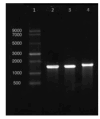Safflower-Derived Cationic Lipid Nanoparticles: Potential Impact on the Delivery of SARS-CoV-2 MRNA Transcripts
- PMID: 40599452
- PMCID: PMC12207921
- DOI: 10.32592/ARI.2024.79.6.1217
Safflower-Derived Cationic Lipid Nanoparticles: Potential Impact on the Delivery of SARS-CoV-2 MRNA Transcripts
Abstract
The COVID-19 pandemic has significantly highlighted the successful application of lipid nanoparticles (LNPs) as an advanced platform for mRNA vaccine delivery. Ionizable lipid is the main component for complexing the mRNA in LNP formulation and in vivo delivery. In the first step of this study, we used the native safflower oil seed to prepare dilinoleyl alcohol. Then the cationic lipid DLin-MC3-DMA (MC3) was synthesized by mixing the alcohol with dimethylamino butyric acid. Safflower-derived MC3 was applied to formulate an LNP vector with standard composition. The efficiency of the synthetic cationic lipid was evaluated for delivering an mRNA-based vaccine encoding the receptor-binding domain (RBD) of SARS-CoV-2. The produced mRNA-LNP vaccine candidate was evaluated in size, morphology, mRNA encapsulation efficiency, apparent pKa, and stability for nucleic acid delivery. Cellular uptake was determined by measuring the percentage of GFP expression, and cytotoxicity was assayed using MTT. The MC3 formation was confirmed by the NMR spectra and used as a cationic lipid in LNP formulation. The obtained LNPs had positively charged and appropriate particle sizes (~80 nm) to confer proper encapsulation efficiency for mRNA delivery and stability. The LNPs were shown to be effective in the transfection of mRNA transcripts into HEK293T cells. A high level (72.34%) of cellular uptake was determined by measuring the percentage of GFP expression. The cytotoxicity assay using MTT showed that both LNP and mRNA-LNP were non-toxic to cells. These data demonstrate the potential of the proposed safflower-derived cationic lipid in the formulation of LNP. The carrier provides a promising platform for the efficient delivery of mRNA in vitro. Further evaluations of its potential for in vivo delivery are needed.
Keywords: Cationic Lipid; Lipid-based Nanoparticles; SARS-CoV-2; Safflower oil; mRNA vaccine.
Conflict of interest statement
The authors declare that they have no conflicts of interest.
Figures






Similar articles
-
Impact of ionizable lipid type on the pharmacokinetics and biodistribution of mRNA-lipid nanoparticles after intravenous and subcutaneous injection.J Control Release. 2025 Aug 10;384:113945. doi: 10.1016/j.jconrel.2025.113945. Epub 2025 Jun 10. J Control Release. 2025. PMID: 40505892
-
Lipid Nanoparticles Formulated with a Novel Cholesterol-Tailed Ionizable Lipid Markedly Increase mRNA Delivery Both in vitro and in vivo.Int J Nanomedicine. 2025 Jul 28;20:9389-9405. doi: 10.2147/IJN.S527822. eCollection 2025. Int J Nanomedicine. 2025. PMID: 40755461 Free PMC article.
-
Standardizing a Protocol for Streamlined Synthesis and Characterization of Lipid Nanoparticles to Enable Preclinical Research and Education.bioRxiv [Preprint]. 2025 Aug 1:2025.07.31.667476. doi: 10.1101/2025.07.31.667476. bioRxiv. 2025. PMID: 40766677 Free PMC article. Preprint.
-
Signs and symptoms to determine if a patient presenting in primary care or hospital outpatient settings has COVID-19.Cochrane Database Syst Rev. 2022 May 20;5(5):CD013665. doi: 10.1002/14651858.CD013665.pub3. Cochrane Database Syst Rev. 2022. PMID: 35593186 Free PMC article.
-
Antibody tests for identification of current and past infection with SARS-CoV-2.Cochrane Database Syst Rev. 2022 Nov 17;11(11):CD013652. doi: 10.1002/14651858.CD013652.pub2. Cochrane Database Syst Rev. 2022. PMID: 36394900 Free PMC article.
References
-
- Midoux P, Pichon C. Lipid-based mRNA vaccine delivery systems. Expert Rev Vaccines. 2015;14(2):221–234. - PubMed
MeSH terms
Substances
LinkOut - more resources
Full Text Sources
Medical
Miscellaneous
